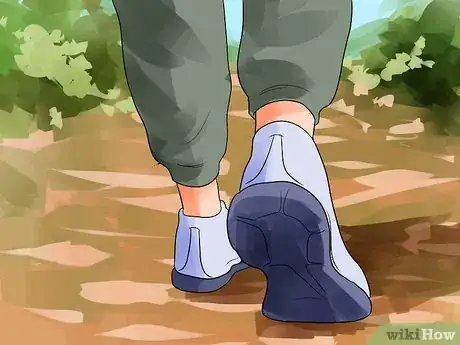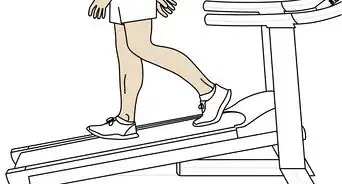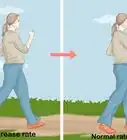This article was co-authored by Patricia Ladis PT, CBBA. Patricia Ladis PT, CBBA is a Licensed Physical Therapist and the Founder of WiseBody Physical Therapy out of New York, NY. With over 22 years of experience, Patricia specializes in providing a collaborative and holistic approach to pain, including nerve and chronic pain, injury prevention, and prenatal/postpartum wellness. She holds a BS in Physical Therapy from New York University. Patricia is a Certified Behavioral Breathing Analyst (CBBA) and holds certifications in Kinetic Control’s Performance Matrix Assessment Screen and the Integrative Systems Model. She co-founded First 1000 Days of Wellness, an educational platform for practitioners and the public to improve perinatal wellness. Patricia has been featured in Forbes, Vogue, and Men’s Health and has made television appearances on NBC and CBS.
There are 7 references cited in this article, which can be found at the bottom of the page.
This article has been viewed 86,445 times.
For some, walking is a difficult task. You may have excuses like, "I'm too tired" or, "I'm missing my favorite program." Meanwhile, you're missing out on a nice outdoor activity and the chance to destress and upgrade your health. With an open mind, the right music, and the right path, walking can be your new favorite go-to exercise or even meditative hobby.
Steps
Preparing for Your Outing
-
1Check the weather. You’ll need to make sure it's a nice day outside to know if it’s good for a walk.[1] Walking isn't fun on extremely hot, cold, or on rainy days. In bad weather, it’s easy to get out there, try it, and just get discouraged and have to turn around. Not enjoyable in the slightest.
- Be extremely careful in the wintertime, especially if enjoying a walk in freshly fallen snow. Hidden ice under the snow could result in an injury.
-
2Dress in comfortable clothing. You don't want your skin to be irritated as you are walking, which will cut your walking short and start the connection in your brain between walking and pain. Make sure your clothing is loose and matches the atmosphere outside. Check if you need a jacket before you head out. The more comfortable you are, the more enjoyable your walk will be.[2]
- If you are walking at night, then your clothing should be brightly colored or have night reflectors. Safety is a priority, even if you’re not a fast target.[3]
- Wear comfy, but appropriate shoes. Wearing sandals, flip-flops, or any other non-support shoes not designed for walking could result in injury.
Advertisement -
3Think of walking as an adventure.[4] Think of all the sights you’re going to see that you’ve probably never noticed before. Try to imagine the warm breeze in your face and the sun radiantly beaming on your body. Clear your mind of all distractions, but make sure you still concentrate on where you are walking![5]
- The world is full of so much stimuli that our brains are physically incapable of processing it all. Even if you walk the same walk time and time again, there are going to be things you notice for the first time every time. Take your time to truly immerse yourself in nature.[6]
-
4If you're walking in an unfamiliar setting, bring your phone, a GPS, or a map. If you’re not confident where you are, you’ll want a device to help get you back home. Carrying a phone with a built-in GPS is best as you may need to make a phone call in an emergency.
- You may want to let a friend or family member know your walking schedule and where you walk, especially if you don't make a habit of carrying your phone. If something were to happen to you, they would have a better idea of how to get to you should you need help.
-
5Grab your iPod or mp3 player and a bottle of water. There are two cheap things that make any walk more enjoyable: music and water. Music keeps your legs moving and your body grooving, and water keeps you hydrated (which is especially important in hot weather). Bring neither and you may wind up slow-moving and thirsty, which does not spell for a nice walk.
- If you’re going on quite the jaunt, you may want to bring a snack. A package of nuts, a granola bar, or a piece of fruit are easy, healthy options to pack for your walk.
Starting a Walking Routine
-
1Start with short walks at first. Take a walk around your neighborhood or in a familiar park setting. Walk on flat terrain, as it is much harder to walk on a bumpy surface (like gravel). If a short walk is all you can handle, that’s okay. Even a short walk is good for your health, lowering your blood pressure, heart rate, and aiding in weight loss.[7]
- As an added bonus to the health benefits of walking, your endurance usually responds very quickly to walking. If you find you can only walk a city block comfortably, take the next two days off, then try again. You'll probably be pleasantly surprised to discover you can comfortably walk further with each passing day.
-
2Bring along a friend. Walking alone is great, but sometimes having a companion for great conversation makes it even better. You can both enjoy the exercise together and reap the health benefits, in addition to enjoying each others’ company.
- What’s more, walking with a friend is safer, too. There’s strength in numbers and should anything bad happen to either one of you, you have better odds of being okay with a friend in tow.[8]
-
3Walk at different times of day. As you start walking, you may find that you don’t enjoy walks mid-afternoon. Maybe it’s just too hot or the area you’re walking in is full of schoolchildren. In that case, don’t blame it on the walk; instead, walk at a different time of day. You may find that your body is more open to walking at different times, too.[9]
- Sunrise or sunset are absolutely fantastic times to walk if your schedule so allows. The sun creates a golden glow over the horizon, illuminating everything in its path, and there are usually fewer runners, walkers, and bikers to crowd your path.
-
4Pay attention to your surroundings. Going on your walk like a robot defeats the purpose of walking. Being in nature and being a part of your surroundings is one of the best aspects of walking. Every time you go out, find one thing you never noticed before. Hey, is that a dollar on the ground?!
- This is also safer. You’ll notice what to avoid, like cracks in the sidewalk, rocks, or animal excrement. You’ll also find new little paths you never knew existed, see new flowers, trees, or even do a little window peaking!
Keeping Your Walks Enjoyable
-
1After you've become accustomed to shorter walks, try going for a longer walk. Sometimes it takes a while for your brain to sink into what it’s doing and get into a groove. Because of that, a nice, long walk and can be exponentially more rewarding. Good places include a large park, a new part of town, a shopping district (for people watching), or another neighborhood.
- Should you ever get too tired, winded, or lightheaded, immediately sit down. Rest, take a drink and wait until you've fully recuperated before attempting to carry on.[10]
-
2Wear a pedometer. One of the best ways to keep up your motivation when it comes to exercising is to know exactly how you’re doing. A pedometer (and yes, there is an app for that if you want to use your phone) keeps track of how many steps you took and some can also record the time. How many steps have you taken today? Can you beat yesterday’s number?
- With a pedometer, you can set goals. Do you want to take 2,000 steps? 5,000? 10,000? For the record, there’s about 2,000 steps per mile. The current recommendation for heart health and maintaining a healthy weight is about 10,000 steps a day, or 5 miles.[11]
-
3Take a break to soak in your surroundings and concentrate on your senses. You don’t always have to be walking during your walks. Find a nice bench, sit down, and take it all in. What kind of birds are those chirping in the distance? And those trees, what are they?
- During your break, use all your senses. Find a smell you didn’t notice before. Look for new angles to photograph. Touch those flowers you always just walk by. This can be even more destressing than the walk itself.
-
4Make your walking more meditative. Walking alone can be a great pleasure, offering the opportunity for meditation, quiet thought, or even just deep breathing. These do not incur any expense and can add a significant emotional/spiritual dimension to your exercise. Here are a couple of ideas:
- Do active, deep abdominal breathing, perhaps synchronizing it with your steps. You’ll be listening to your body instead of listening to the thoughts running wild through your mind, which can offer a sense of mental calm.
- Repeat a meditative phrase, positive affirmations, or prayer in your mind synchronous with your breathing or your steps. You’ll come back from your walk feeling positive, confident, and motivated to take your next walk soon.
-
5Switch it up. Make sure that walking becomes a daily routine, but doesn’t become boring. Find two or three places you enjoy walking, and rotate them in your schedule. Walk at different times of day, different lengths, and with different music or with different people. By now, you should be enjoying your trip. Have fun strolling!
Expert Q&A
-
QuestionHow much should I walk during pregnancy?
 Patricia Ladis PT, CBBAPatricia Ladis PT, CBBA is a Licensed Physical Therapist and the Founder of WiseBody Physical Therapy out of New York, NY. With over 22 years of experience, Patricia specializes in providing a collaborative and holistic approach to pain, including nerve and chronic pain, injury prevention, and prenatal/postpartum wellness. She holds a BS in Physical Therapy from New York University. Patricia is a Certified Behavioral Breathing Analyst (CBBA) and holds certifications in Kinetic Control’s Performance Matrix Assessment Screen and the Integrative Systems Model. She co-founded First 1000 Days of Wellness, an educational platform for practitioners and the public to improve perinatal wellness. Patricia has been featured in Forbes, Vogue, and Men’s Health and has made television appearances on NBC and CBS.
Patricia Ladis PT, CBBAPatricia Ladis PT, CBBA is a Licensed Physical Therapist and the Founder of WiseBody Physical Therapy out of New York, NY. With over 22 years of experience, Patricia specializes in providing a collaborative and holistic approach to pain, including nerve and chronic pain, injury prevention, and prenatal/postpartum wellness. She holds a BS in Physical Therapy from New York University. Patricia is a Certified Behavioral Breathing Analyst (CBBA) and holds certifications in Kinetic Control’s Performance Matrix Assessment Screen and the Integrative Systems Model. She co-founded First 1000 Days of Wellness, an educational platform for practitioners and the public to improve perinatal wellness. Patricia has been featured in Forbes, Vogue, and Men’s Health and has made television appearances on NBC and CBS.
Licensed Physical Therapist Pregnant women should work on taking 30 minutes brisk walks every day. Remember that, when it comes to health benefits, consistency is key!
Pregnant women should work on taking 30 minutes brisk walks every day. Remember that, when it comes to health benefits, consistency is key! -
QuestionHow can I get strength in my arms if I cannot hold myself up at all? I cannot plank and I have no ability to push up.
 Community AnswerStart with very light weights and go up from there. As you get stronger, you can try doing push ups or planks on your knees, and then eventually try them with your knees off the ground.
Community AnswerStart with very light weights and go up from there. As you get stronger, you can try doing push ups or planks on your knees, and then eventually try them with your knees off the ground. -
QuestionI get so bored on walks and I don't have any music and I can't have friends because I'm in lockdown. What do I do?
 FennickoCommunity AnswerYou could use a pastime as old as time: enjoy the sights and sounds! This is actually more interesting than you think!
FennickoCommunity AnswerYou could use a pastime as old as time: enjoy the sights and sounds! This is actually more interesting than you think!
Warnings
- Make sure where you walk is safe.⧼thumbs_response⧽
- Walk with a destination in mind, even if it's just to the end of your street and back. As your walking improves, always plan your walks in a loop, thus bringing you to your point of destination, until you are quite sure of your stamina. You wouldn't want to attempt walking around a park lake, only to discover you're too winded to get back.⧼thumbs_response⧽
- Bring a cell phone, but remember a cell phone won't protect you, and small defensive weapon (like pepper spray) in case of an assault, but make sure that it really is an assault.⧼thumbs_response⧽
- If you don't feel well, don't walk. You may infect others or pass out.⧼thumbs_response⧽
- Always check first with a doctor or qualified health professional if either your health or breathing has been previously compromised. Always walk with a partner should you have any health concerns.⧼thumbs_response⧽
- To help ensure you have help getting home for the return walk, go somewhere that has a bus, subway, or some other similar connection to take you back home; that way you can go further and don't need to worry about exhaustion too much.⧼thumbs_response⧽
References
- ↑ Patricia Ladis PT, CBBA. Licensed Physical Therapist. Expert Interview. 19 March 2021.
- ↑ https://www.heart.org/en/healthy-living/fitness/fitness-basics/what-to-wear-when-you-work-out
- ↑ https://blog.mypacer.com/2018/03/27/8-important-tips-for-nighttime-walkers/
- ↑ Patricia Ladis PT, CBBA. Licensed Physical Therapist. Expert Interview. 19 March 2021.
- ↑ https://www.betterhealth.vic.gov.au/health/healthyliving/walking-for-good-health
- ↑ Patricia Ladis PT, CBBA. Licensed Physical Therapist. Expert Interview. 19 March 2021.
- ↑ http://www.heart.org/HEARTORG/GettingHealthy/PhysicalActivity/Walking/Walk-Dont-Run-Your-Way-to-a-Healthy-Heart_UCM_452926_Article.jsp
- ↑ https://www.betterhealth.vic.gov.au/health/healthyliving/walking-for-good-health
- ↑ https://www.betterhealth.vic.gov.au/health/healthyliving/walking-for-good-health








































































